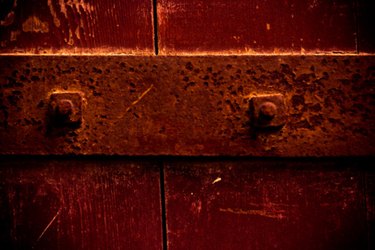
Rust is a process of decay that occurs when iron and oxygen are in the presence of water or moisture in the air. Many other metals go through a similar process, but the resulting oxides are not called "rust." The term, however, has colloquially evolved as an umbrella term for all metal decay.
Stage One
Video of the Day
Deposits on the surface of the metal with a red, black or white coloration will form. This will be partnered with a small amount of etching and pitting. At this stage, the rust is attacking the surface of the metal. The rust can be treated easily with either sand blasting or chemically cleaning.
Video of the Day
Stage Two
This rust now takes on a powdered or granular condition. Scaling can develop as flakes of metal become loose and fall off. The base metal will still be unaffected at this stage; therefore, the metal can be easily treated with sand blasting or chemical cleaning.
Stage Three
The surface appearance of stage three rust is very similar if not identical to the appearance of rust in stage two, except that the underlying decay will be more severe. The base metal in the areas of corrosion will have been compromised; small pinholes may be present. At this stage, the metal must be repaired after it has been cleaned and primed.
Stage Four
Stage four rust represents corrosion and decay that have developed to a point at which the base metal has been completely penetrated and removed. No metal will remain at the points of corrosion in stage four. Extensive repair will be required after the metal has been cleaned and primed.